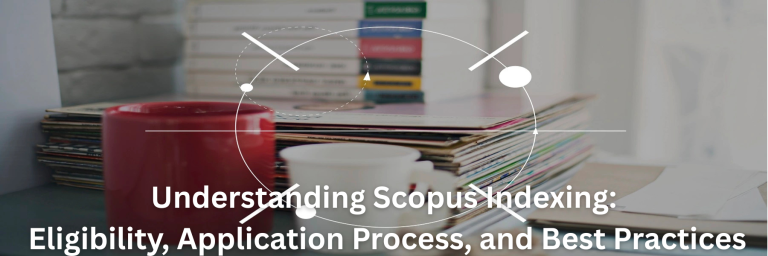Steps To Getting Journals Indexed By Scopus

Are you a researcher and have written a brilliant paper? You must want to get it published in a recognized journal. There are numerous publications available that enable academics to share their research. Amongst these, those indexed by Scopus are the most popular.
The database comprises approximately 40,000 Scopus indexed journals across various fields of study. It is the top choice for scholars seeking relevant articles. It upholds strict standards, which makes it a highly trusted platform for scholars. For researchers and journal publishers, this provides excellent opportunities.
Being listed by this scholarly database is the dream of many. However, understanding the requirements for a publication can be somewhat challenging.
Here is a guide to walk you through the Scopus journal indexing process for a successful journey. But before that, you need to understand what Scopus indexing is.
What Are Scopus-Indexed Journals?
These are academic publications included in the Scopus database. It’s a leading citation and abstract database that covers several areas of study. Scopus indexed journals publication go through review by the Content Selection and Advisory Board (CSAB).
The publication must meet high standards for quality, editorial integrity, and contribution. This database provides access to abstracts and citations from millions of academic sources. These include articles, conference appearances, and book chapters.
How to Get Your Journal Indexed By Scopus
Here are the steps you can take to get listed by this scholarly database
- Ensure Compliance with Selection Criteria
The first step in getting indexed by this database is to meet the selection criteria. Read the Scopus journal indexing guidelines carefully. Your journal must have a clear scope and an editorial board comprising qualified experts.
Additionally, the publications must have an established process for peer review. Furthermore, you must also demonstrate ethical publishing practices.
- Provide Quality Content
This journal listing system has high standards for the publications in terms of content. Your publication must feature high quality research articles of international relevance.
Additionally, your publication must be issued regularly. It must also have an International Standard Serial Number (ISSN). This is an 8-digit code to identify serial publications such as journals and newspapers. It acts as a unique identifier instead of titles.
- Meet Technical Requirements
Apart from regular issuance, your publications must have detailed metadata. Pay close attention to the Digital Object Identifier (DOI) for the published articles. Ensure your journal features full text articles in HTML or PDF format.
In addition to this, your bibliographic information should be machine readable.
Steps to Getting Indexed By Scopus
Now you know how to increase the chances of getting listed by this scholarly database. Here are the steps you can take for a smoother process.
- Do A Final Check
Before submitting your application, make sure it meets the Scopus journal indexing guidelines. Go over your peer review process, editorial board policy, and issuance schedule.
For a successful indexing, look out for any mistakes or errors. Remove them immediately to enhance the chances of being accepted.
- Make a Scopus Profile
Once your publications meet the outlined criteria, visit the Scopus website to create a profile. This is an essential step since the application process cannot begin without it.
You will be required to provide your email address, name, and create a strong password. Then, you will need to search for your author profile and claim it.
- Prepare Your Documents
Gather all relevant documents listed on the indexing system. This will also include a description of your publications and manuscripts of your work. You’ll be required to provide your issuance history and sample issues.
Organize these documents carefully to avoid any last minute mishaps. Ensure they are neatly and properly arranged to present them professionally.
- Submit Your Application
The next step is to submit your application. Carefully fill out the online submission form. Double check the information for accuracy to avoid any mistakes. They can get your application rejected.
- Wait for Assessment
Once you have submitted your application, your publication will go through a detailed evaluation process. This will be carried out by SCAB.
The review process is a rigorous one. You may have to wait several months for an update. Avoid contacting the board repeatedly since it can create a negative impression.
- Make Necessary Changes
If the selection and advisory board provides any kind of feedback, respond accordingly. They may also request additional information, so please provide it as soon as possible.
Pay close attention to the critical feedback to improve the quality of your publication. This will increase the chances of getting listed.
- Get Indexed
This is the last step of the Scopus journal indexing process. If your journal is accepted for listing, you will be contacted to deliver the content. If it still requires improvement for acceptance, you will be provided with further feedback.
Why Scopus Indexed Journals are Important
Getting listed by this scholarly database has several benefits. Here are some of the most prominent ones:
- Enhanced Visibility
Scopus indexed journals have global recognition. Being listed by this database means gaining a much wider audience. These publications have a higher number of citations compared to competitors, with figures of 10 to 15% more citations.
- Reputation Building
As a researcher, you need to build a credible image of yourself. Being indexed in this scholarly database will strengthen your academic position. With manuscript writing services, you can receive new opportunities for collaboration.
- Global Networking
This scholarly database helps researchers from all around the world connect. It also provides chances for collaboration, which contributes to better scholarly work.
Commonly Asked Questions
- What criteria are journals judged on?
This scholarly database evaluates publications based on their content quality and standing. Additionally, they are also assessed for the regularity of issuance and online accessibility.
- What are some strategies to get my publications listed?
While submitting your application, provide clear editorial policies and guidelines for the selection board. Also, offer the full list of editorial board members along with their affiliations.
- What qualifies as high standard content for the database?
The journal should regularly publish original and authentic research that makes an academic contribution. The articles should be well written and follow a logical structure. This also includes tables, figures, and careful formatting.
- How is the journal’s standing assessed?
The selection board evaluated publications based on the editor’s expertise. Apart from this, the citation is also judged. Its articles should be cited in the Scopus database or other indexed publications.
Conclusion
Having a journal indexed by this scholarly database is the dream of many. It is widely acknowledged for its authenticity and global reach. The process of having your publications recognized by it is challenging and requires considerable patience. But the results are highly rewarding.
By following the discussed steps, you can increase the chances of getting indexed by this highly recognized academic database. Don’t be discouraged if your application isn’t accepted on the first submission. Use the given feedback to improve your publication. This will enhance the chance of acceptance with the next application.


